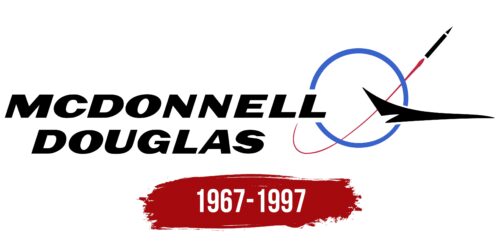The McDonnell Douglas logo reflects the company’s connection to the aerospace industry and symbolizes the conquest of space beyond Earth’s orbit. With a simple emblem, the manufacturer of airplanes, rockets, and spacecraft demonstrated its drive for technical progress.
McDonnell Douglas: Brand overview
In the 1920s and 1930s, McDonnell Douglas originated from Douglas Aircraft Company and McDonnell Aircraft Corporation. Donald Wills Douglas established the Douglas Aircraft Company in 1921 in Santa Monica, California. Initially focusing on military aircraft, the company became a commercial aviation leader.
In 1933, Douglas introduced the DC-1 and then the DC-2, revolutionizing passenger air travel. On the other hand, McDonnell Aircraft Corporation was founded by James Smith McDonnell in 1939 in St. Louis, Missouri, initially focusing on experimental aircraft and rocket technology. During World War II in the 1940s, both companies made significant contributions to the US war effort. Douglas produced A-20 Havoc bombers and C-47 Skytrain transport aircraft, while McDonnell worked on developing new military aviation technologies.
In the 1950s, Douglas continued to dominate the commercial air travel market with the DC-6 and DC-7 aircraft, later introducing the DC-8 jet airliner in 1958. McDonnell focused on military contracts, developing successful combat aircraft like the F-101 Voodoo and the F-4 Phantom II.
In the 1960s, despite the success of the DC-9, Douglas faced financial challenges due to heavy investments in the development of the DC-10. Meanwhile, McDonnell excelled in the military sector and participated in NASA’s space program, developing the Mercury spacecraft. The historic merger between Douglas Aircraft Company and McDonnell Aircraft Corporation on April 28, 1967, led to the creation of McDonnell Douglas Corporation, combining commercial aviation expertise with military and space capabilities.
In the 1970s, McDonnell Douglas continued working on military and civilian projects, introducing the successful wide-body DC-10 and the F-15 Eagle fighter. In the 1980s, the company faced tough competition from Boeing and Airbus in the commercial airliner market but succeeded with the MD-80. McDonnell Douglas contributed to the Space Shuttle program in the space sector by producing external fuel tanks. The 1990s saw the development of new aircraft like the MD-11 and MD-90, but financial difficulties and rising competition led to a decline in market share. However, the company succeeded in the military sector with the F/A-18 and Super Hornets.
In 1996, merger talks with Boeing began, driven by industry consolidation and financial challenges. The official merger announcement on August 1, 1997, created the world’s largest aerospace company. The merger marked the end of McDonnell Douglas as a standalone entity, but its legacy lived on in Boeing’s products and technologies.
Meaning and History
What is McDonnell Douglas?
It is a legendary American aerospace corporation formed from the merger of McDonnell Aircraft and Douglas Aircraft Company, two pioneers of the aviation industry. The company gained fame for developing a wide range of iconic commercial and military aircraft, such as the DC-9, MD-80, F-4 Phantom II, and F-15 Eagle, which revolutionized air transport and defense capabilities. The organization played a key role in the U.S. space program, producing various components and vehicles, including Delta rockets and the orbital stage for the space shuttle.
1967 – 1997
The McDonnell Douglas logo will be familiar to anyone who knows the Boeing emblem, as it is its foundation. The abstract design originally depicted the United States’ victory in the race for the first around-the-world flight. The small airplane represents the Douglas World Cruiser, which circled the globe in 175 days. However, the silhouette does not match the original DWC shape because the company wanted to show the evolution of airliners and the emergence of new, modern models.
It resembles a military aircraft in appearance. Douglas merged with McDonnell, a fighter jet manufacturer, in 1967 and included it in the emblem. The small black rocket, leaving a long purple trail, references another McDonnell product—spacecraft.
The large blue ring represents the globe that the DWC planes circled. Its presence creates a sense of transglobal reach, and the surrounding space is perceived as an open cosmos. This symbolizes the company’s confident progression into the future alongside technical advancements.
The emblem’s designers left the ring open, placing the last letter of “McDonnell” between the two ends. The second part of the brand name is on the lower line, visually balancing the logo’s elements. The inscription uses a confident, sans-serif uppercase font in black, reflecting the company’s serious intentions. The contrasting thickness of the strokes and the noticeable slant of the glyphs infuse the text with internal dynamism.




